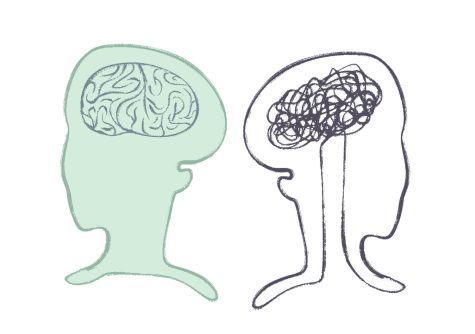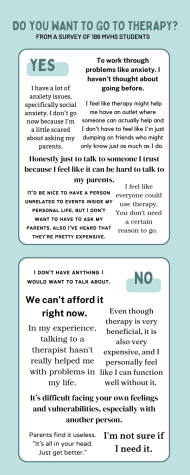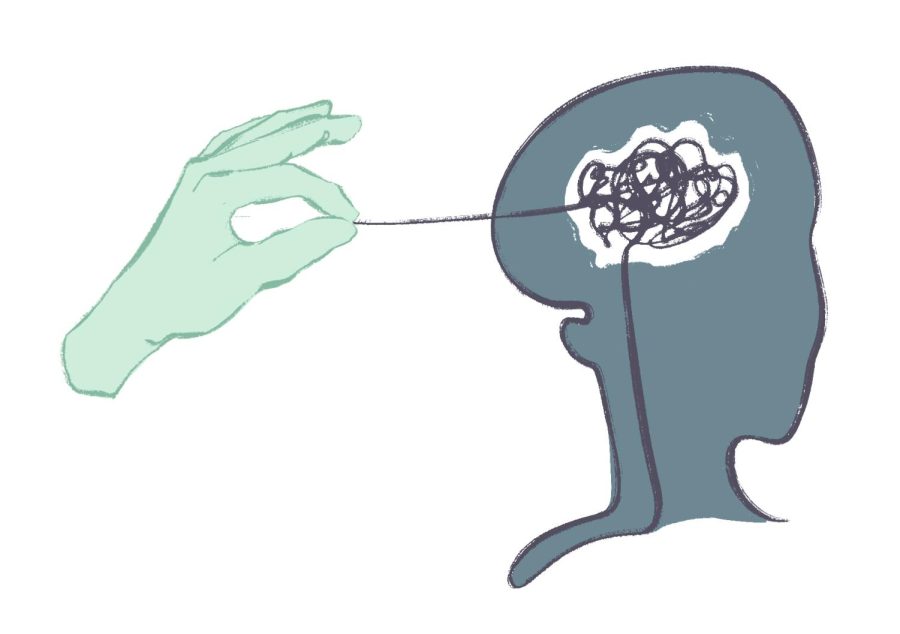Should I get help?
Examining different opinions on the stigma surrounding therapy
MVHS students voice their opinions on different aspects of therapy.
February 16, 2023
Content warning: This story contains brief descriptions of self-harm.
“Before I went to therapy, I thought it was a really big thing. I felt like it tells people that you’re not very stable,” junior Prerana Dilip said. “But it’s just like ranting to someone about your issues — just like talking to a friend.”
After being diagnosed with ADHD, anxiety and depression at the end of the last school year, Dilip started going to therapy to address her mental health as well as self-harming practices. Going to therapy has not only been helpful for Dilip in boosting her mental well-being, but it has also dispelled the internalized stigma that surrounds those who seek treatment.
While Dilip was able to find the mental health help she needed, school-based therapist Leila Lurie fears that this stigma around therapy may deter others from seeking the same treatment for their own mental health. She claims that this stigma, especially in a predominantly-Asian community such as Cupertino, may also stem from cultural beliefs about mental health.
“I think various cultures have very different ideas about therapy and just this notion of whether you keep it at home or you spread your business elsewhere,” Lurie said. “I do think that there are barriers associated with accessing therapy, and I think there are various mindsets and cultural views that strongly believe that they can take care of this inner stuff in the family or as an individual.”

In the past few years, however, there has been an ongoing push to destigmatize the idea of mental health — through adopting the mantra, “we all have mental health” — and as a subdivision of the movement, the act of going to therapy through its own mantra, “everyone should go to therapy.”
These efforts have not been fruitless. A record 90% of US adults believe there is a mental health crisis and are willing to discuss topics surrounding mental health, while 21.6% are seeking counseling to further their internal wellness.
“I think everyone should go to therapy because [it] doesn’t mean that you’re mentally ill,” Dilip said. “It just means that you want to learn more about yourself and control your emotions.”
But a significant barrier to destigmatizing therapy remains. In the U.S., the average cost of therapy ranges from $100 to $200 per session. Dilip says the high cost of therapy deters many from seeking treatment and believes that if “they made it more accessible to people, then more people [would] be willing to try it out.” School-based therapist Leila Lurie echoes that cost hinders people from being able to go to therapy but adds that there are resources for those who view cost as its main disadvantage.
“I know that therapy has been seen as something that is very costly and only reserved for a few. That’s not necessarily true,” Lurie said. “And there are resources out there for folks who have lower income all the way up to private pay and then other insurance in between. So it’s a matter of figuring out how to access resources that fit in the budget.”
Senior Eric Ju, however, says that paying hundreds of dollars for therapy isn’t necessarily worth the price for everybody. Unlike Dilip, he believes that although therapy can be useful for those with specific struggles they are trying to find solutions for, there is no reason to attend therapy unless you have issues that actively need to be resolved and if you’re not willing to take actionable steps to resolve your internal problems.
“While it is nice to have someone to talk to, I feel like, to a certain extent, the therapist can say ‘oh, you have to do XYZ’, right,” Ju said. “But if you don’t do the things that they suggest you to do, I feel like you’re not going to get the results that you want. So I feel like, from what I’ve seen, those who benefit the most out of therapy are the ones that are most open-minded to what the therapist says.”

Ju reasons that, to some extent, “a good portion of therapy is just… talking [about] all your problems [with] someone else”, and that a trusted friend or adult may also be able to offer a safe space to vent and helpful insights. Lurie agrees that there are other ways to improve one’s mental health that are less expensive than therapy: there is research, she says, that lists exercise, eating healthy and sleeping well as methods that are just as effective for therapy for mild to moderate depression.
However, for students who specifically want to talk to a therapist but don’t know how to access therapy and other mental health resources, Lurie says that there is a general education therapist available to all students on campus as well as wellness check-in forms on the MVHS website. She highlights that the role of the school district is to “help people access long-term ongoing therapy,” and “it’s a matter of knowing who to go to.” Similarly, Ju maintains that therapy is a long-term process.
“I don’t really believe … that therapy is a one-and-done solution. That’s not really how it works,” Ju said. “When you’re with a therapist, you’re really on a journey of trying to figure out [how to] change your mindset [and] trying to learn different ways to cope with hardship.”
Lurie echoes this statement and emphasizes that the first step to dispelling the stigma against going to therapy is to change the narrative: a therapeutic relationship “doesn’t have to be pathologizing.” She adds that people can view therapy as growth-oriented and a way to help manage one’s mental health rather than a one-time fix.
“I think that [therapy’s] not a cure-all,” Lurie said. “But I think connection is the most important thing for humans and that isolation is the most devastating thing for us. And so I think a therapist can be somebody that you can have a connection with, and that’s very powerful.”




















